Triple Phase Shift Control of Wireless Charging DAB LCC Resonant Converter for Unity Power Factor Operation with Optimized Rectifier AC Load Resistance
Abstract
Featured Application
Abstract
1. Introduction
2. DAB DC/DC Resonant Converter TPS Close Loop Control Scheme
2.1. DAB DC/DC Resonant Converter TPS PWM Modulation
2.2. Mathematical Formulation of DAB TPS Control Method
2.2.1. Charging Power Regulation with Inverter Phase Shift Control
2.2.2. Resonant Circuit Load Resistance Regulation with Rectifier Phase Shift Control
2.2.3. Inverter-to-Rectifier Phase Shift Angle Setting for Unity Power Factor Operation of DAB LCC Resonant Converter
2.2.4. DAB LCC Resonant Converter Rectifier AC Voltage Phase Measurement from Receiver Coil Current
2.3. DAB TPS Close Loop Control Scheme for Unity Power Factor Operation of Inverter and Rectifier at Optimized Resonant Circuit AC Load Resistance
2.4. DAB LCC Resonant Converter TPS Control Performance Design Analhysis
2.5. DAB LCC Resonant Converter TPS Control Implementation in PLECS RT Box
2.6. DAB LCC Resonant Converter Open Loop TPS Control Simulation Analysis
2.6.1. DAB LCC Resonant Converter TPS Control with Active Rectifier Control to Achieve Diode Bridge Rectify Performance
2.6.2. DAB LCC Resonant Converter TPS Control for Unity Power Factor Operation
2.6.3. DAB LCC Resonant Converter TPS PWM Modulation ZVS Switching Performance
3. DAB LCC Resonant Converter TPS Control Validation
3.1. Experimental Hardware Setups
3.2. CC Mode and CV Mode Battery Charging Profile Feedback Control Performance
3.3. LCC Resonant Circuit AC Voltage and Current Validation in DAB Steady State Operation
3.4. Experimental Results with/without Rectifier AC Load Resistance Feedback Control
3.5. Performance Evaluation for Inverter-to-Rectiiver Phase Shift Angle δ Setting Change
4. Challenges and Possible Methods to Implement TPS Control in Decoupled Transmitter and Receiver Control Hardware
4.1. Inverter and Rectifier Phase Shift PWM Modulator Implemented in Two Separate Control Hardware
4.2. DAB Converter TPS Control Smooth Poweron Startup Transition with Inverter-to-Rectifier Phase Shift Angle Auto-Adjustment Scheme
4.3. Power on Transition Stage (1)—Smoothly Enable Rectifier Phase Shift Control in Diode Bridge Operation Condition
4.4. Power on Transition Stage (2)—Inverter-to-Rectifier Phase Shift Angle Auto-Adjustment for DAB Unity Power Factor Operation in Rectifier Phase Shift Open Loop Control
4.5. DAB TPS Close Loop Control Stage with Inverter-to-Rectifier Phase Shift Angle Auto-adjustment for DAB Unity Power Factor Operation with Rectifier Feedback Control Enabled
5. Conclusions and Discussions
Author Contributions
Funding
Institutional Review Board Statement
Informed Consent Statement
Data Availability Statement
Acknowledgments
Conflicts of Interest
Abbreviations
| DC | Direct current |
| AC | Alternate current |
| CC | Constant current |
| CV | Constant voltage |
| EV | Electric vehicle |
| LLC | Inductor-inductor-capacitor |
| LCC | Inductor-capacitor-capacitor |
| DAB | Dual active bridge |
| Rx | Receiver |
| Tx | Transmitter |
| WPT | Wireless power transfer |
| PLL | Phase lock loop |
| ZPA | Zero phase angle |
| ZVS | Zero voltage switching |
| DPS | Double phase shift |
| TPS | Triple phase shift |
| EMI | Electromagnetic interference |
References
- Ahmad, A.; Alam, M.S.; Chabaan, R. A comprehensive review of wireless charging technologies for electric vehicles. IEEE Trans. Transp. Electrif. 2017, 4, 38–63. [Google Scholar] [CrossRef]
- Li, S.; Li, W.; Deng, J.; Nguyen, T.D.; Mi, C.C. A Double-Sided LCC Compensation Network and Its Tuning Method for Wireless Power Transfer. IEEE Trans. Veh. Technol. 2015, 64, 2261–2273. [Google Scholar] [CrossRef]
- Galigekere, V.P.; Onar, O.; Pries, J.; Zou, S.; Wang, Z.; Chinthavali, M. Sensitivity analysis of primary-side LCC and secondary-side series compensated wireless charging system. In Proceedings of the 2018 IEEE Transportation Electrification Conference and Expo (ITEC), Long Beach, CA, USA, 13–15 June 2018; IEEE: Piscataway, NJ, USA, 2018; pp. 885–891. [Google Scholar]
- Feng, H.; Cai, T.; Duan, S.; Zhao, J.; Zhang, X.; Chen, C. An LCC-Compensated Resonant Converter Optimized for Robust Reaction to Large Coupling Variation in Dynamic Wireless Power Transfer. IEEE Trans. Ind. Electron. 2016, 63, 6591–6601. [Google Scholar] [CrossRef]
- Haque, M.S.; Mohammad, M.; Pries, J.L.; Choi, S. Comparison of 22 kHz and 85 kHz 50 kW wireless charging system using Si and SiC switches for electric vehicle. In Proceedings of the 2018 IEEE 6th Workshop on Wide Bandgap Power Devices and Applications (WiPDA), Atlanta, GA, USA, 31 October 2018–2 November 2018; IEEE: Piscataway, NJ, USA, 2018; pp. 192–198. [Google Scholar]
- Nguyen, B.X.; Singh, J.; Zhang, X.; Jiang, W.; Koh, L.H.; Wang, P. Design and Control for ZVS Constant Current and Constant Voltage Wireless Charging Systems. In Proceedings of the 2018 IEEE 4th Southern Power Electronics Conference (SPEC), Singapore, 10–13 December 2018; IEEE: Piscataway, NJ, USA, 2018; pp. 1–7. [Google Scholar]
- Zhang, X.; Cai, T.; Duan, S.; Feng, H.; Hu, H.; Niu, J.; Chen, C. A Control Strategy for Efficiency Optimization and Wide ZVS Operation Range in Bidirectional Inductive Power Transfer System. IEEE Trans. Ind. Electron. 2019, 66, 5958–5969. [Google Scholar] [CrossRef]
- Qu, X.; Chu, H.; Wong, S.C.; Chi, K.T. An IPT battery charger with near unity power factor and load-independent constant output combating design constraints of input voltage and transformer parameters. IEEE Trans. Power Electron. 2019, 34, 7719–7727. [Google Scholar] [CrossRef]
- Vu, V.-B.; Tran, D.-H.; Choi, W. Implementation of the Constant Current and Constant Voltage Charge of Inductive Power Transfer Systems with the Double-Sided LCC Compensation Topology for Electric Vehicle Battery Charge Applications. IEEE Trans. Power Electron. 2018, 33, 7398–7410. [Google Scholar] [CrossRef]
- Lu, J.; Zhu, G.; Lin, D.; Zhang, Y.; Wang, H.; Mi, C.C. Realizing Constant Current and Constant Voltage Outputs and Input Zero Phase Angle of Wireless Power Transfer Systems with Minimum Component Counts. IEEE Trans. Intell. Transp. Syst. 2021, 22, 600–610. [Google Scholar] [CrossRef]
- Lu, J.; Zhu, G.; Lin, D.; Zhang, Y.; Jiang, J.; Mi, C.C. Unified Load-Independent ZPA Analysis and Design in CC and CV Modes of Higher Order Resonant Circuits for WPT Systems. IEEE Trans. Transp. Electrif. 2019, 5, 977–987. [Google Scholar] [CrossRef]
- Cao, S.; Naing, H.Y.Y.; Naayagi, R.T.; Lee, S.S.; Wei, F.; Tseng, K.J. Wireless charging resonant converter topology study based on analytical design computation. In Proceedings of the 2020 3rd International Conference on Energy, Power and Environment: Towards Clean Energy Technologies, Shillong, India, 5–7 March 2021; IEEE: Piscataway, NJ, USA, 2021; pp. 1–6. [Google Scholar]
- Cao, S.; Nawawi, A.; Lim, Z.; Ang, J.; Hu, X.; Tong, C.F.; Tseng, K.J. Wireless Charging Technologies and Standardization for Electric Unmanned Crafts. In Proceedings of the 2022 International Power Electronics Conference (IPEC-Himeji 2022-ECCE Asia), Himeji, Japan, 15–19 May 2022; IEEE: Piscataway, NJ, USA, 2022; pp. 2147–2154. [Google Scholar]
- Li, H.; Li, J.; Wang, K.; Chen, W.; Yang, X. A Maximum Efficiency Point Tracking Control Scheme for Wireless Power Transfer Systems Using Magnetic Resonant Coupling. IEEE Trans. Power Electron. 2015, 30, 3998–4008. [Google Scholar] [CrossRef]
- Zhao, Q.; Wang, A.; Liu, J.; Wang, X. The Load Estimation and Power Tracking Integrated Control Strategy for Dual-Sides Controlled LCC Compensated Wireless Charging System. IEEE Access 2019, 7, 75749–75761. [Google Scholar] [CrossRef]
- Li, Z.; Huang, X.; Song, K.; Jiang, J.; Zhu, C.; Du, Z. Constant current charging and the maximum system efficiency tracking for wireless charging systems employing dual-side control. In Proceedings of the 2018 International Power Electronics Conference (IPEC-Niigata 2018-ECCE Asia), Niigata, Japan, 20–24 May 2018; pp. 84–87. [Google Scholar]
- Jiang, Y.; Wang, L.; Wang, Y.; Wu, M.; Zeng, Z.; Liu, Y.; Sun, J. Phase-Locked Loop Combined with Chained Trigger Mode Used for Impedance Matching in Wireless High Power Transfer. IEEE Trans. Power Electron. 2020, 35, 4272–4285. [Google Scholar] [CrossRef]
- Ping, W. Modeling and Simulation of Full-Bridge Series Resonant Converter Based on Generalized State Space Averaging. Appl. Mech. Mater. 2013, 347–350, 1828. [Google Scholar]
- Salem, M.; Jusoh, A.; Idris, N.R.N.; Alhamrouni, I. Modeling and simulation of generalized state space averaging for series resonant converter. In Proceedings of the 2014 Australasian Universities Power Engineering Conference (AUPEC), Perth, Australia, 28 September–1 October 2014; IEEE: Piscataway, NJ, USA, 2014; pp. 1–5. [Google Scholar]
- Yang, E.X. Extended Describing Function Method for Small-Signal Modeling of Resonant and Multi-Resonant Converters. Ph.D Thesis, Virginia Tech, Blacksburg, VA, USA, 1994. [Google Scholar]
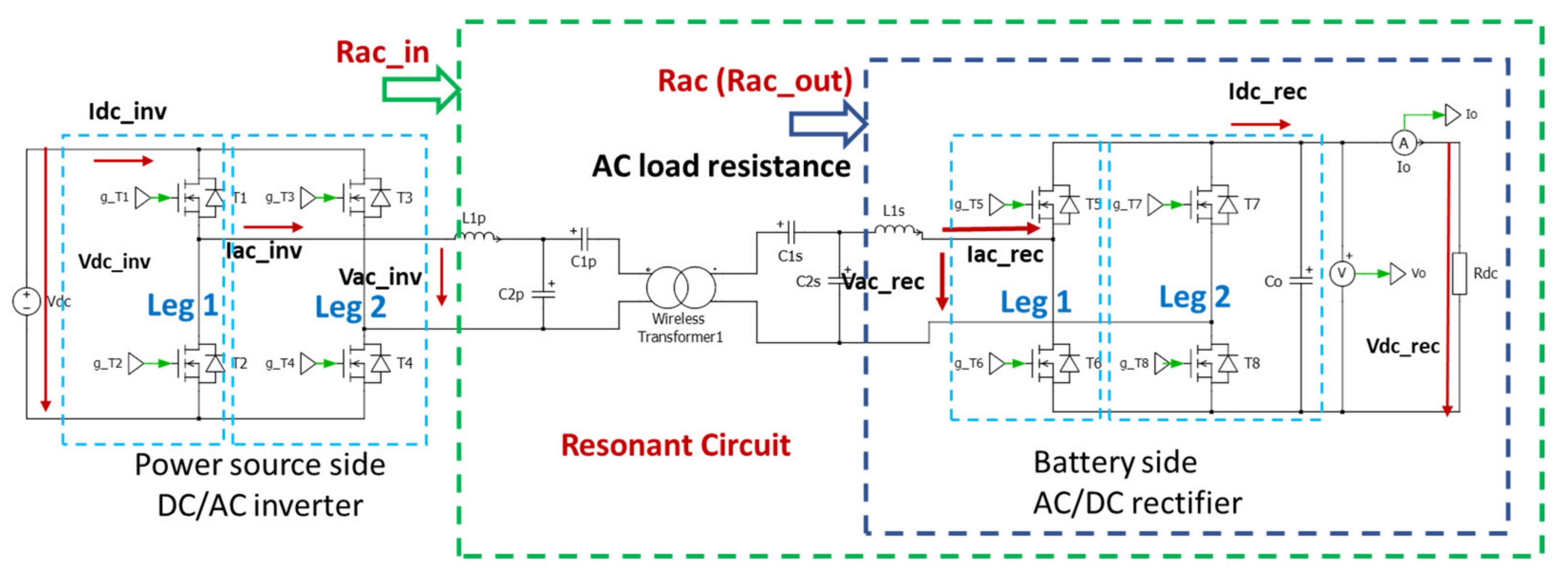
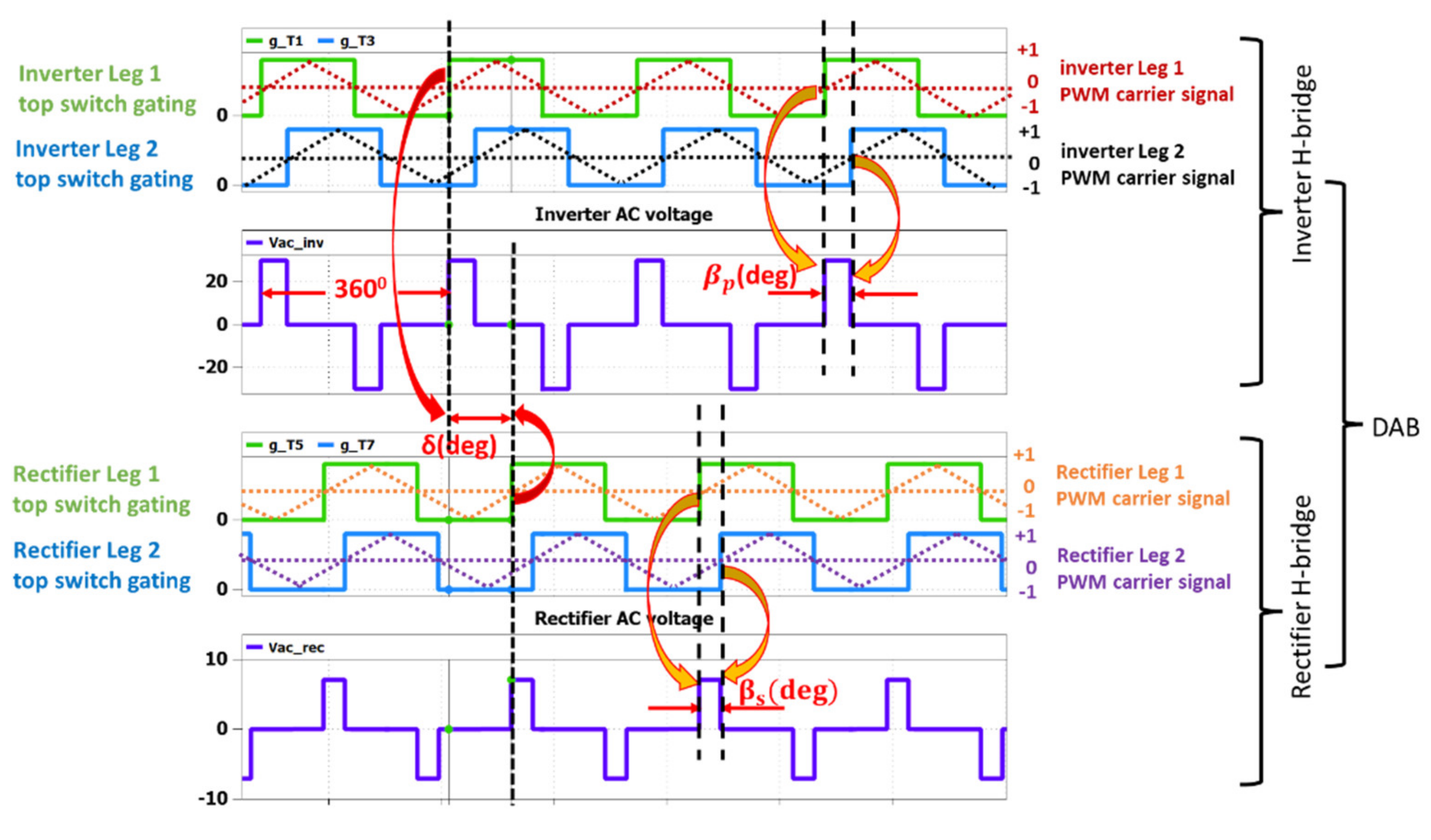




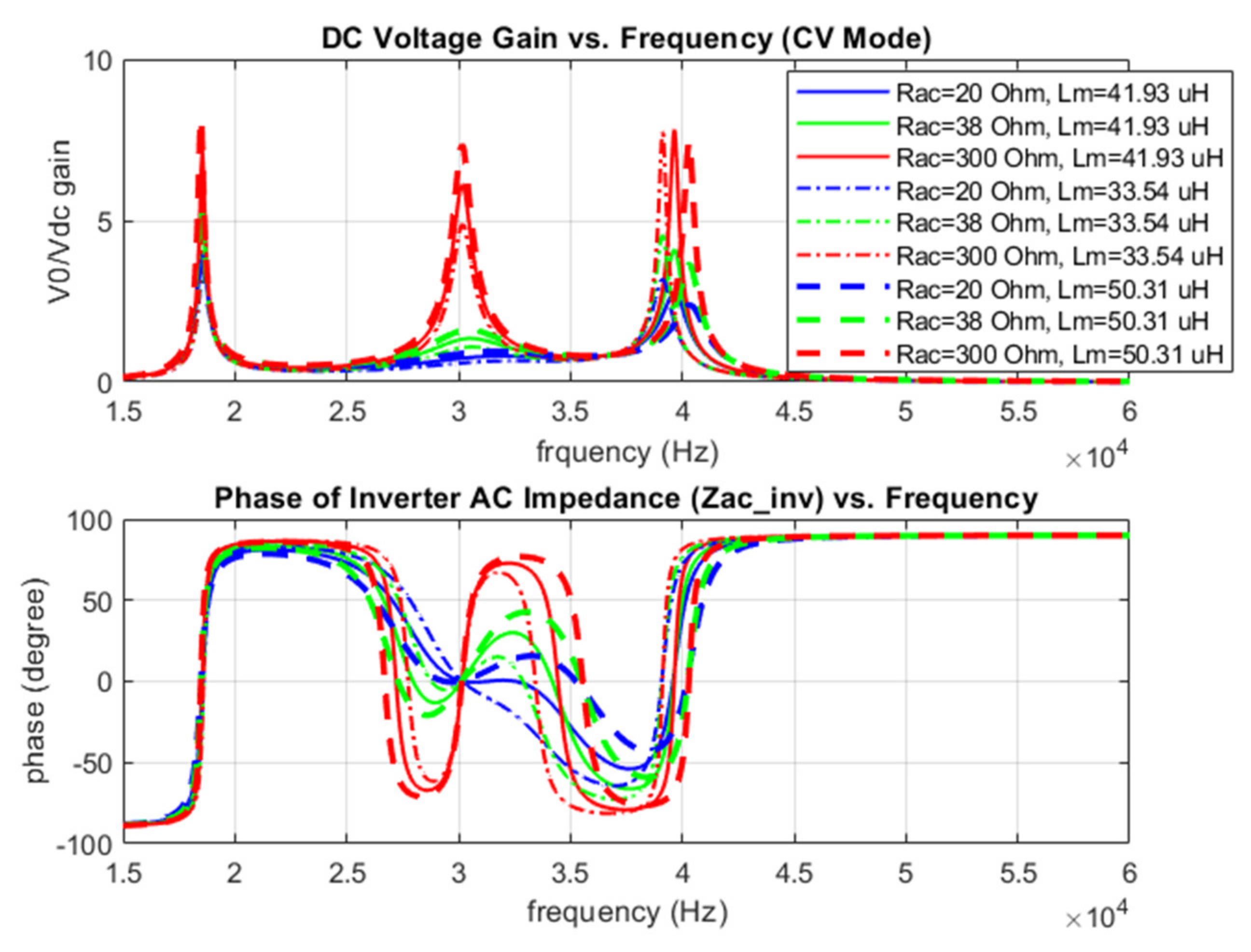


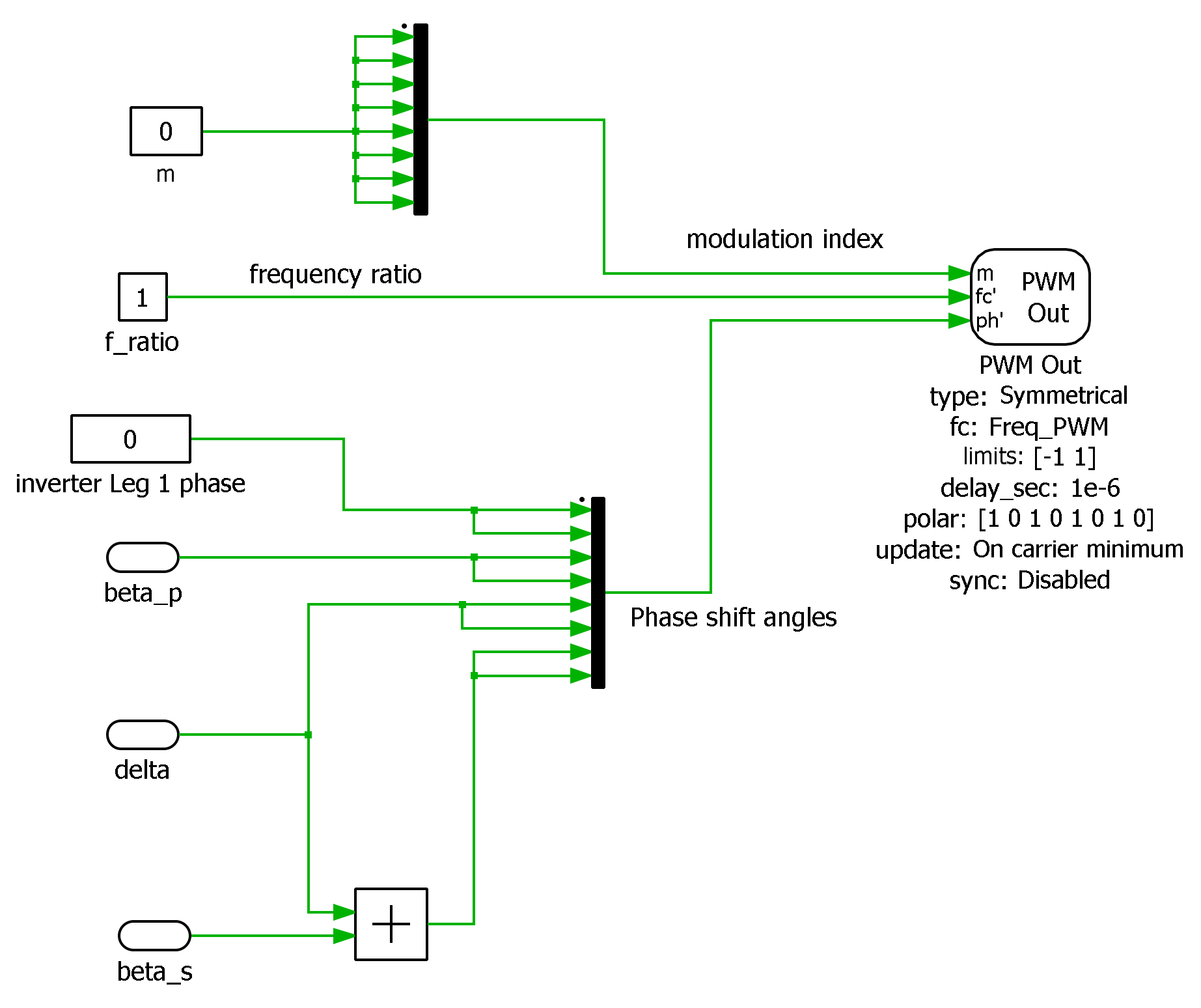
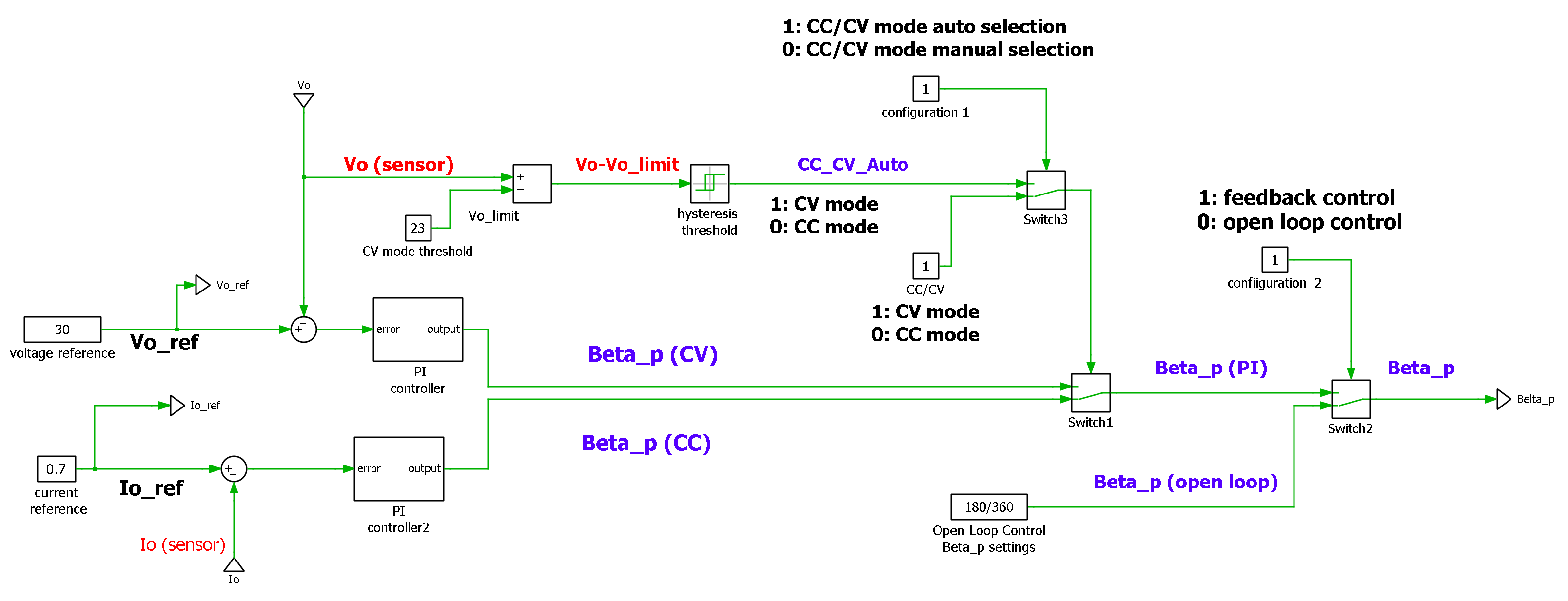

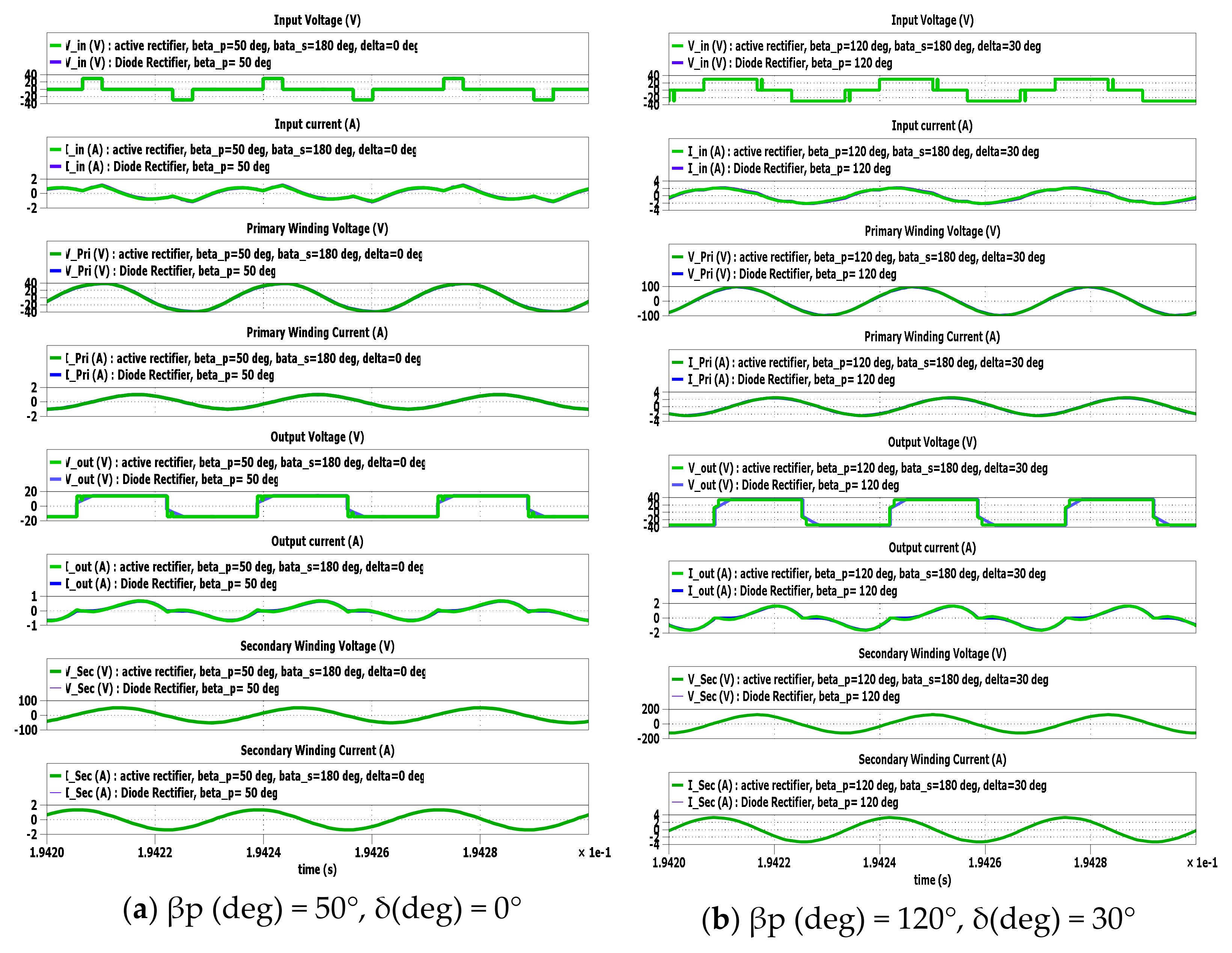

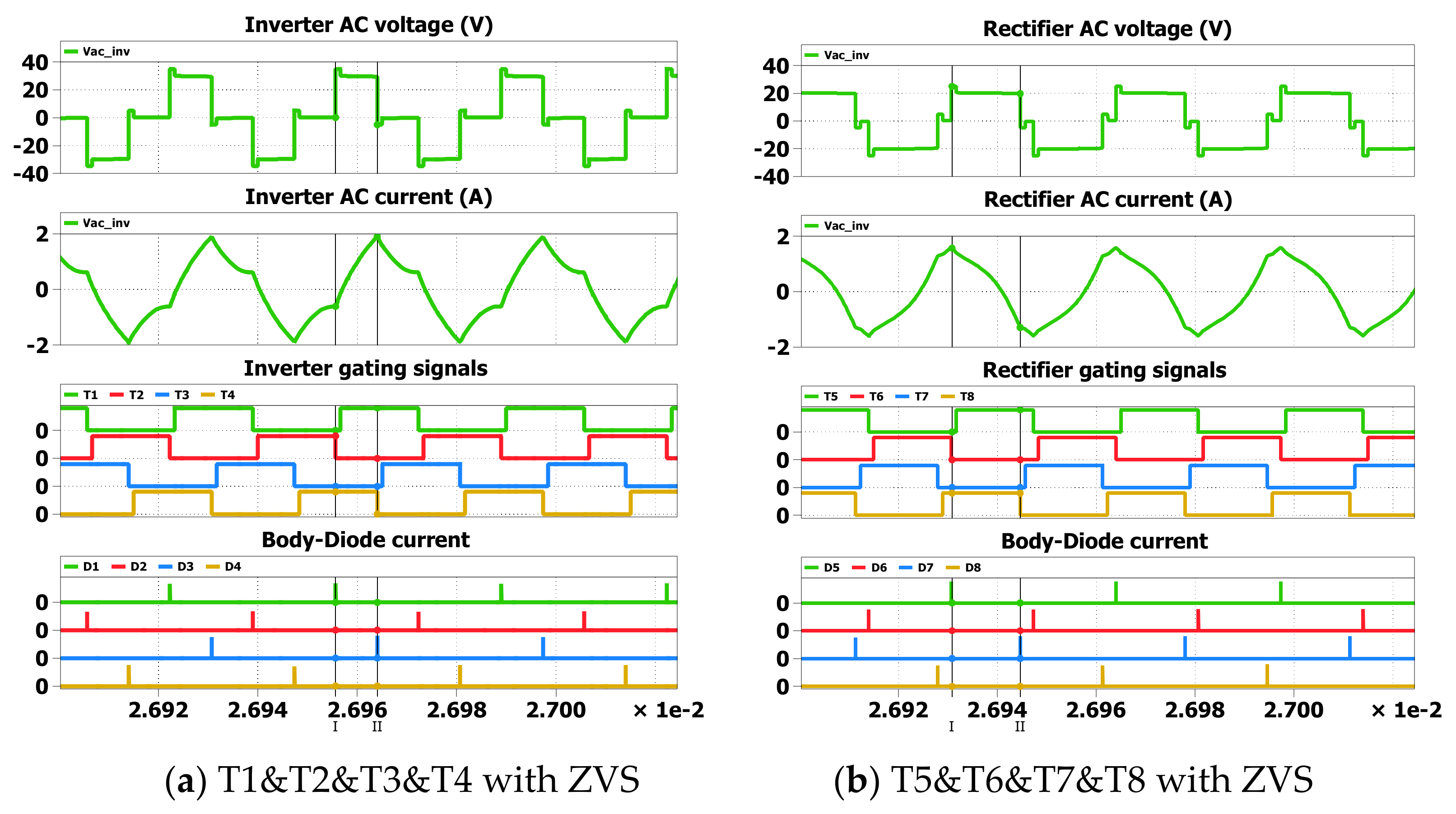

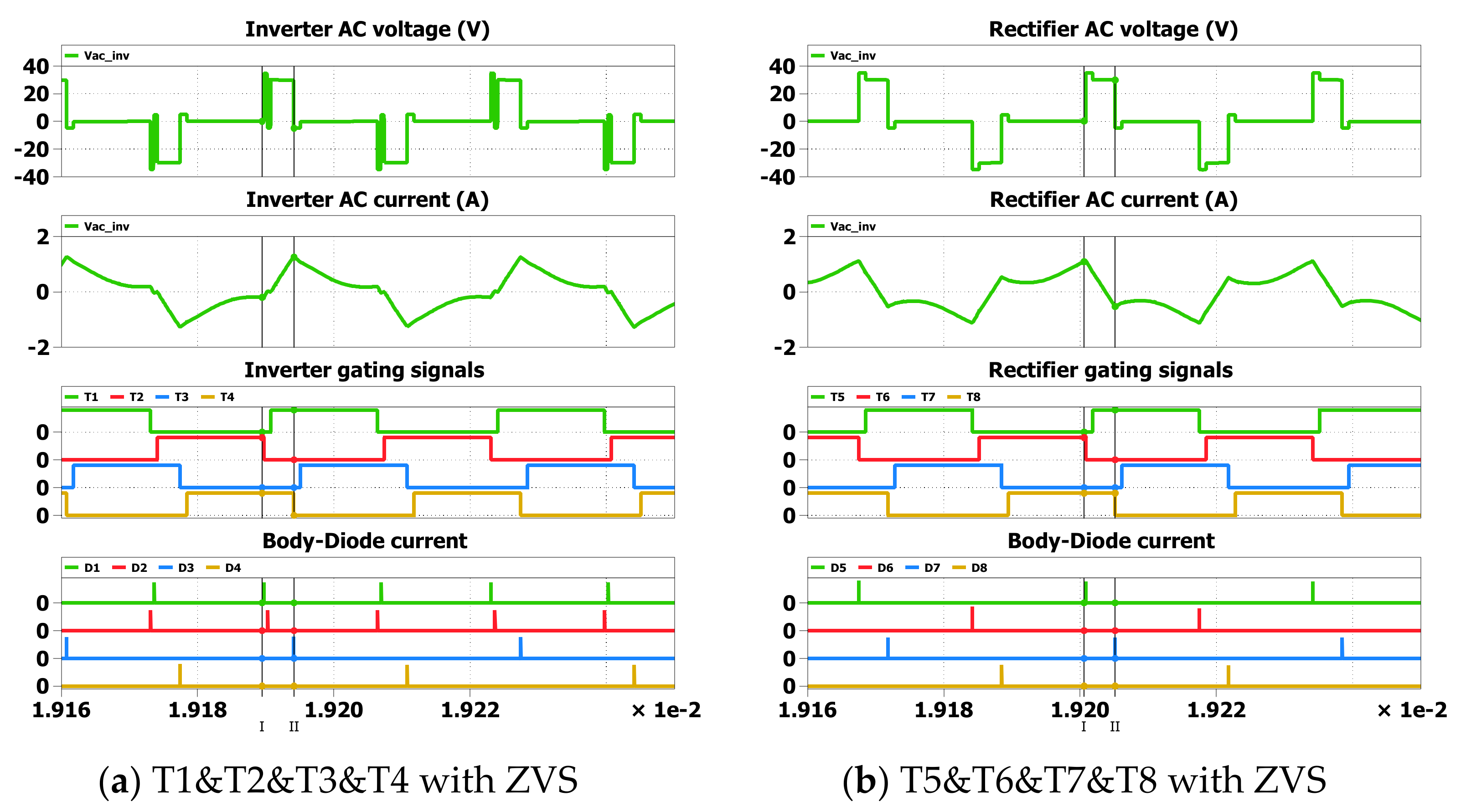
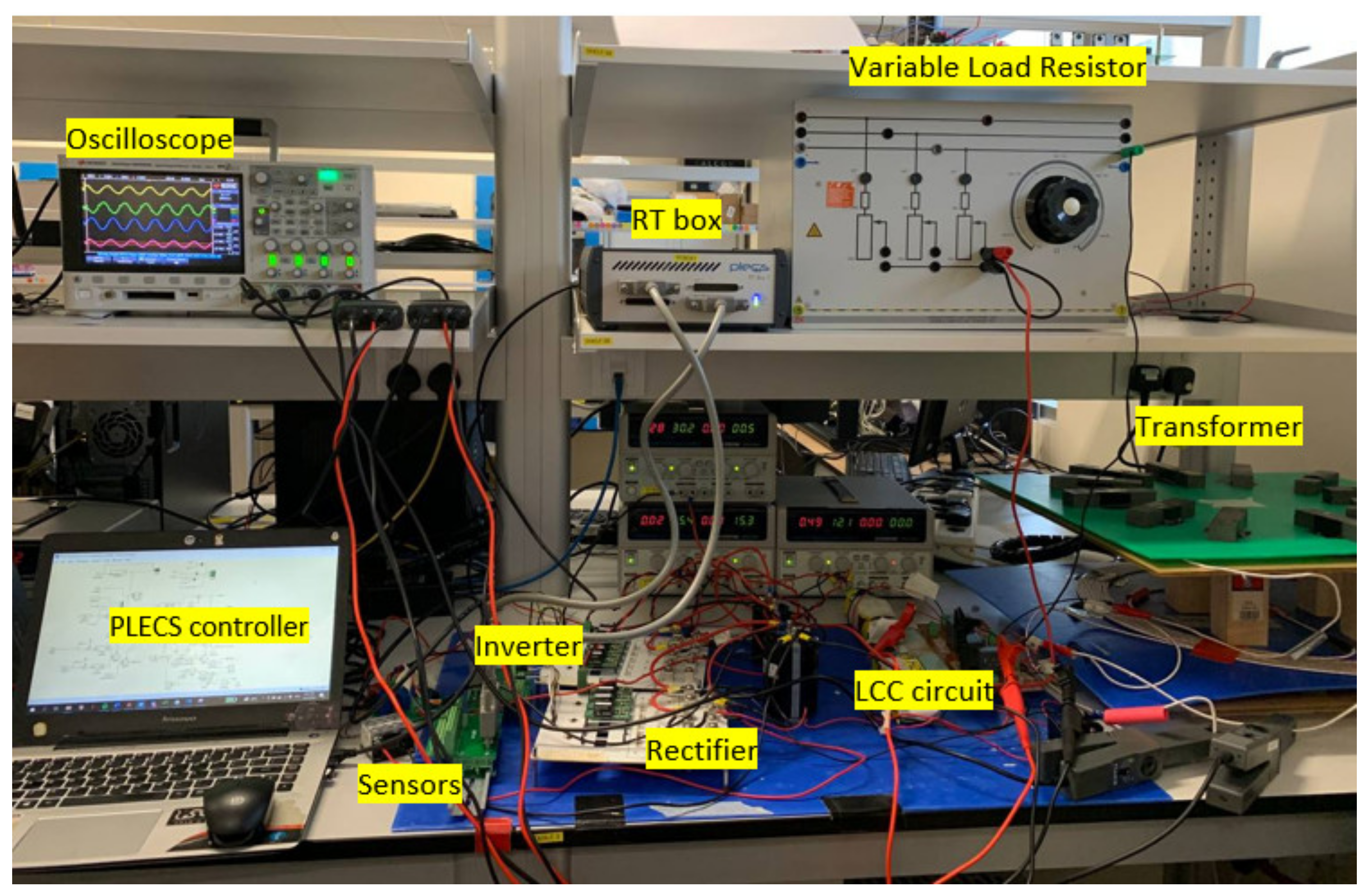


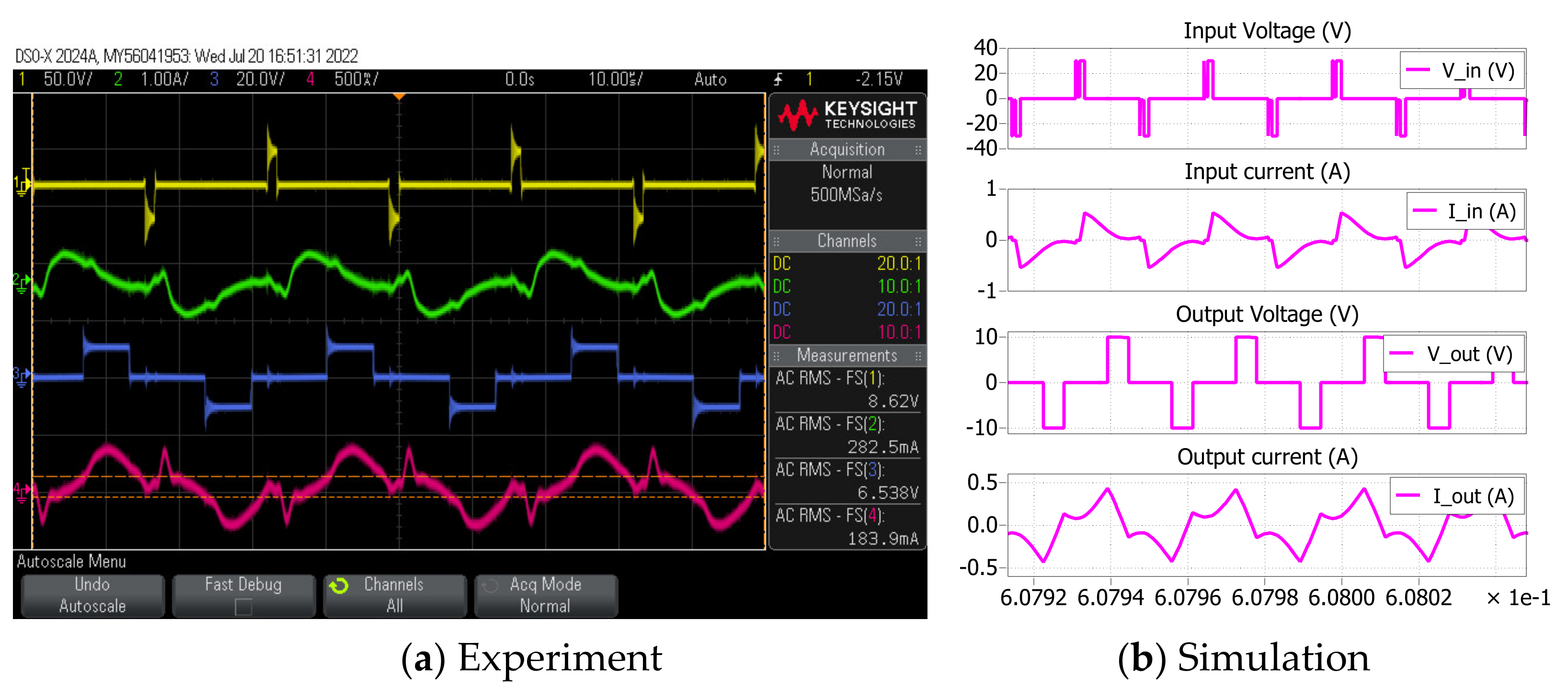

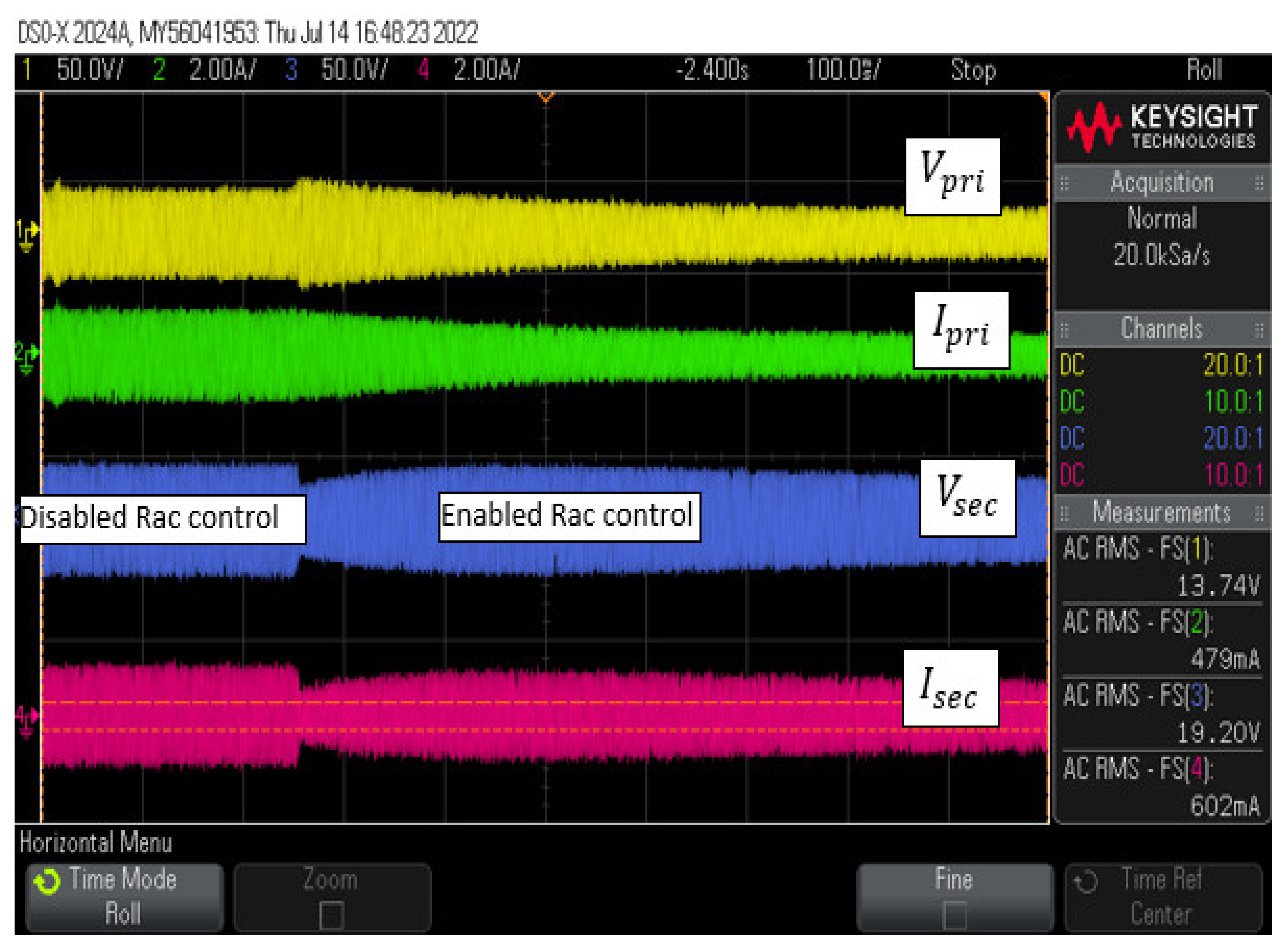
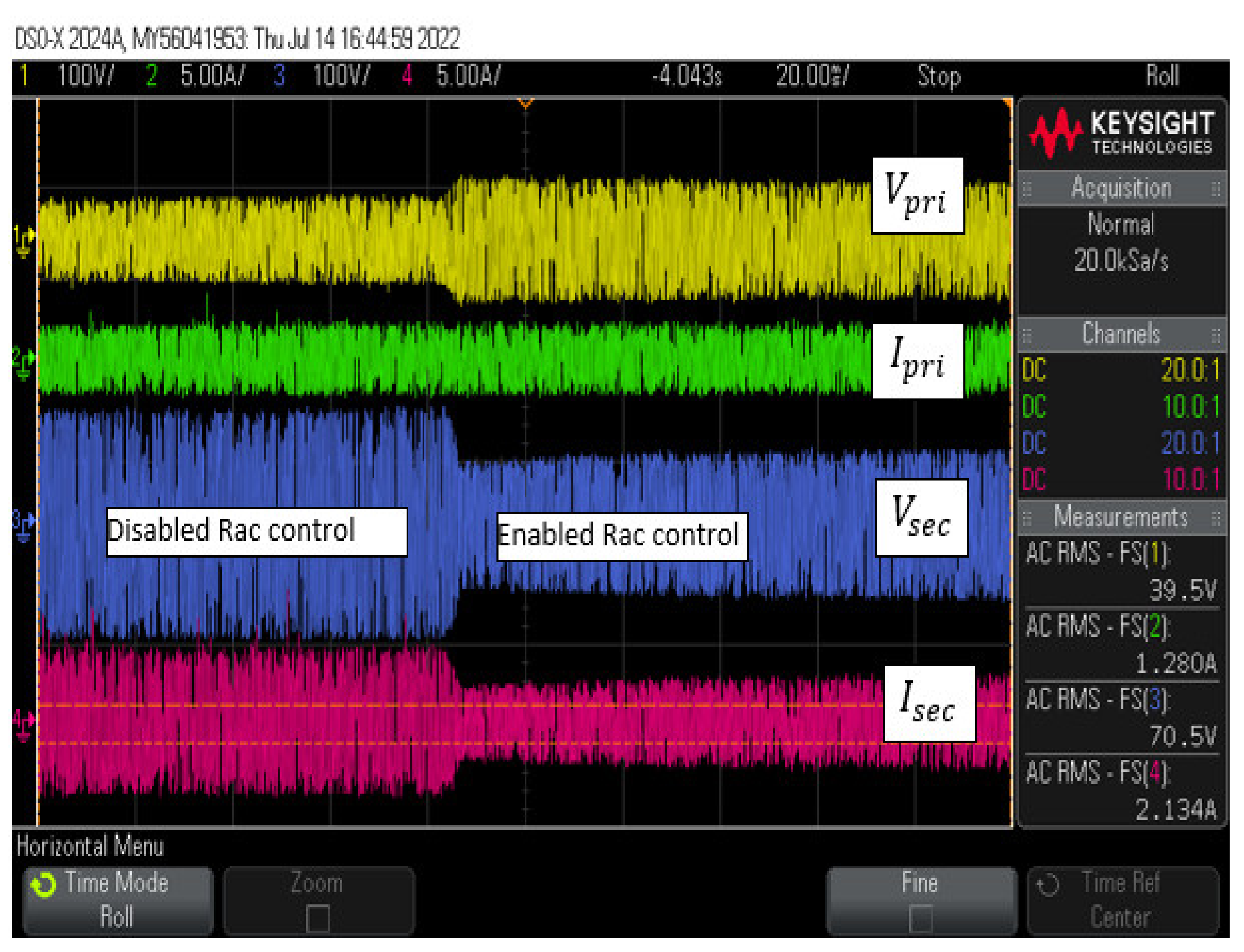
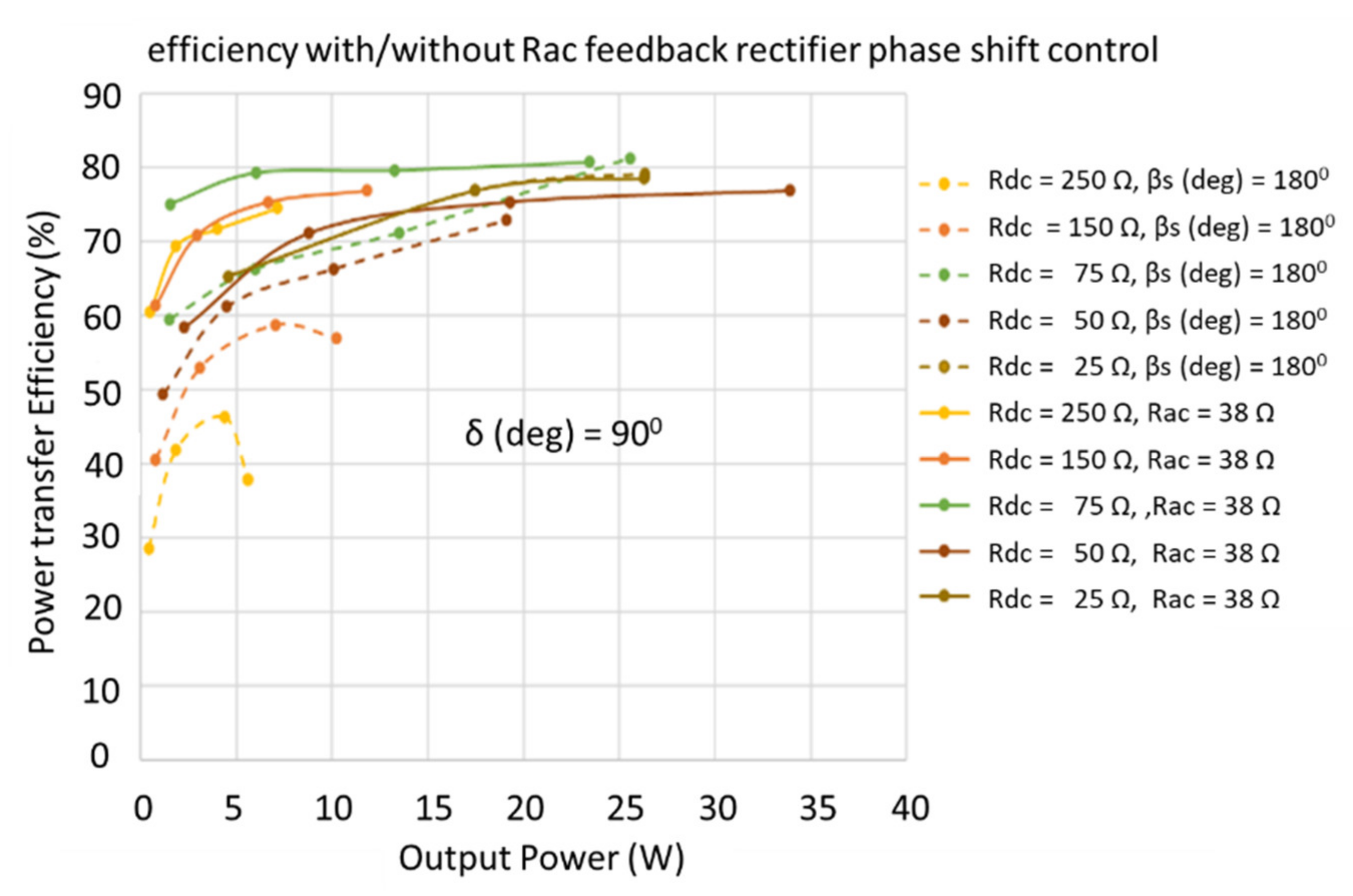
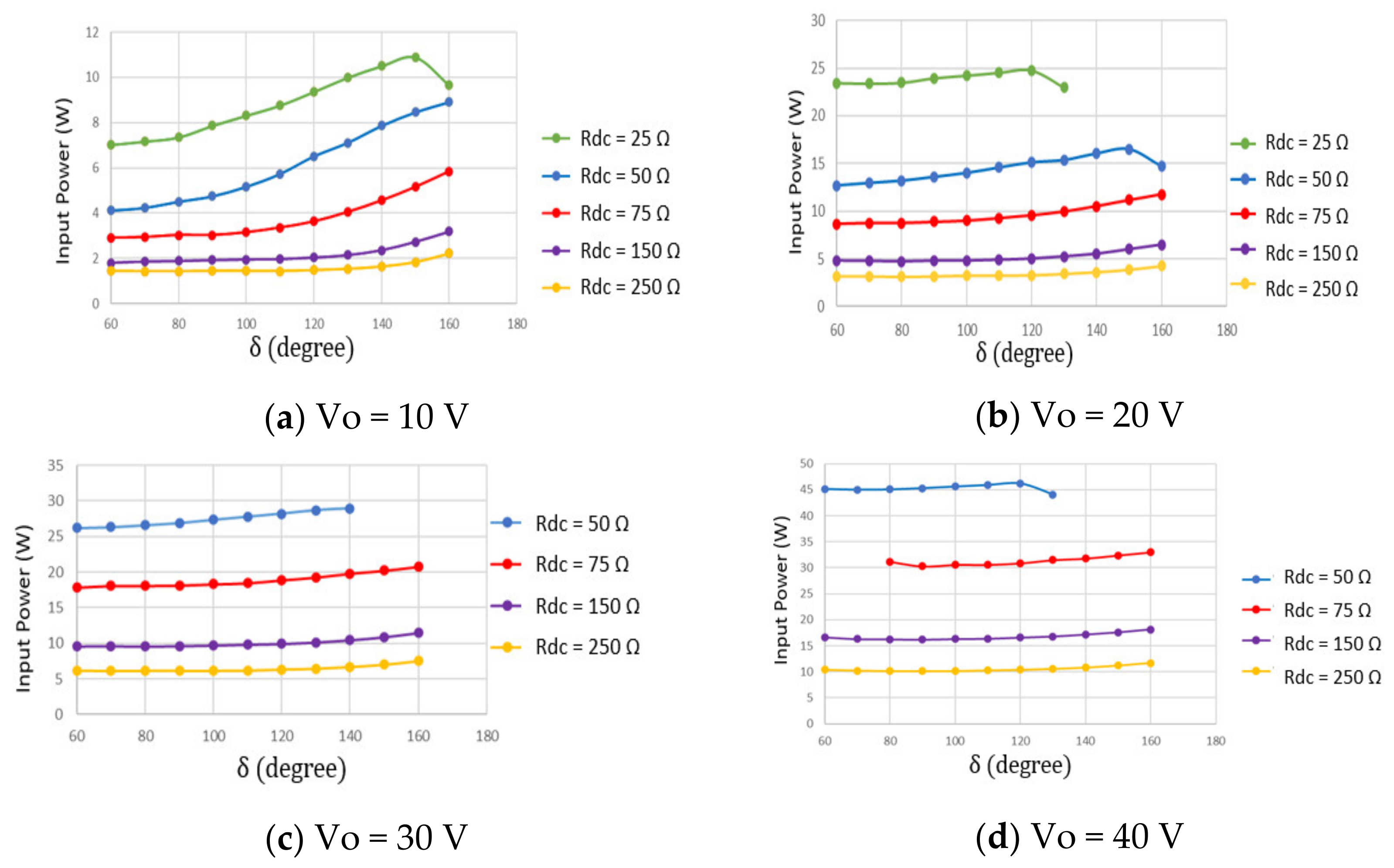

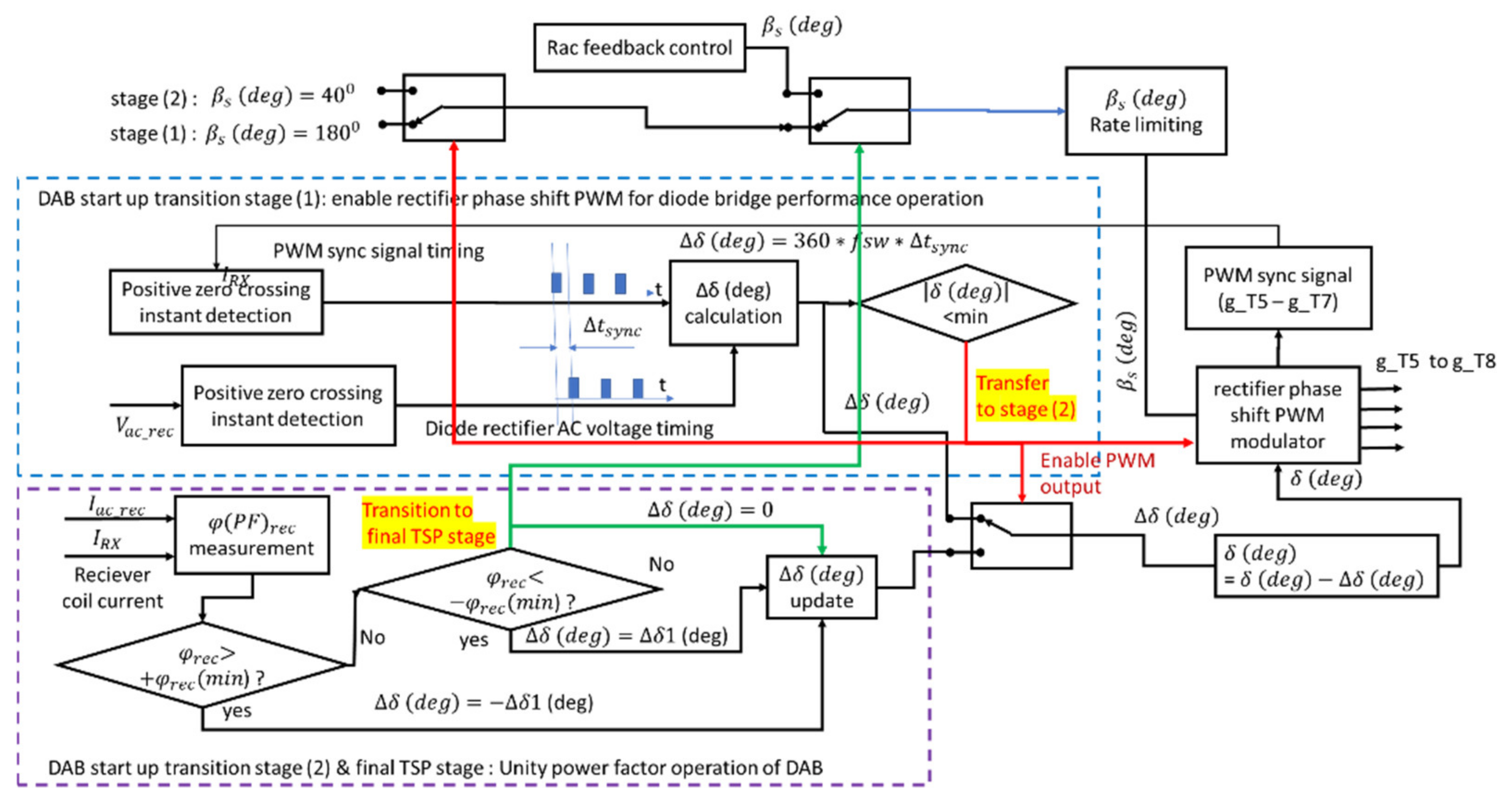
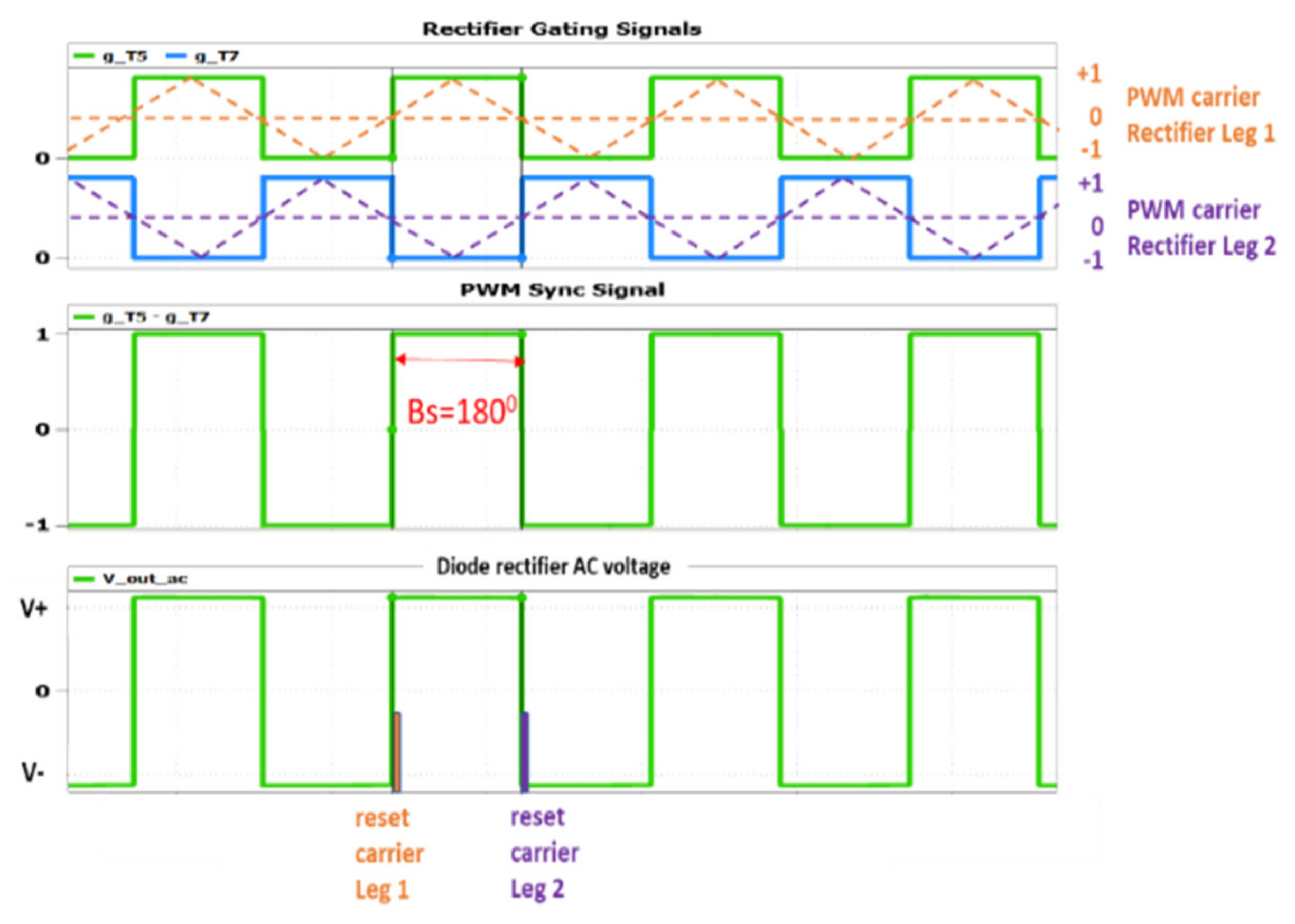

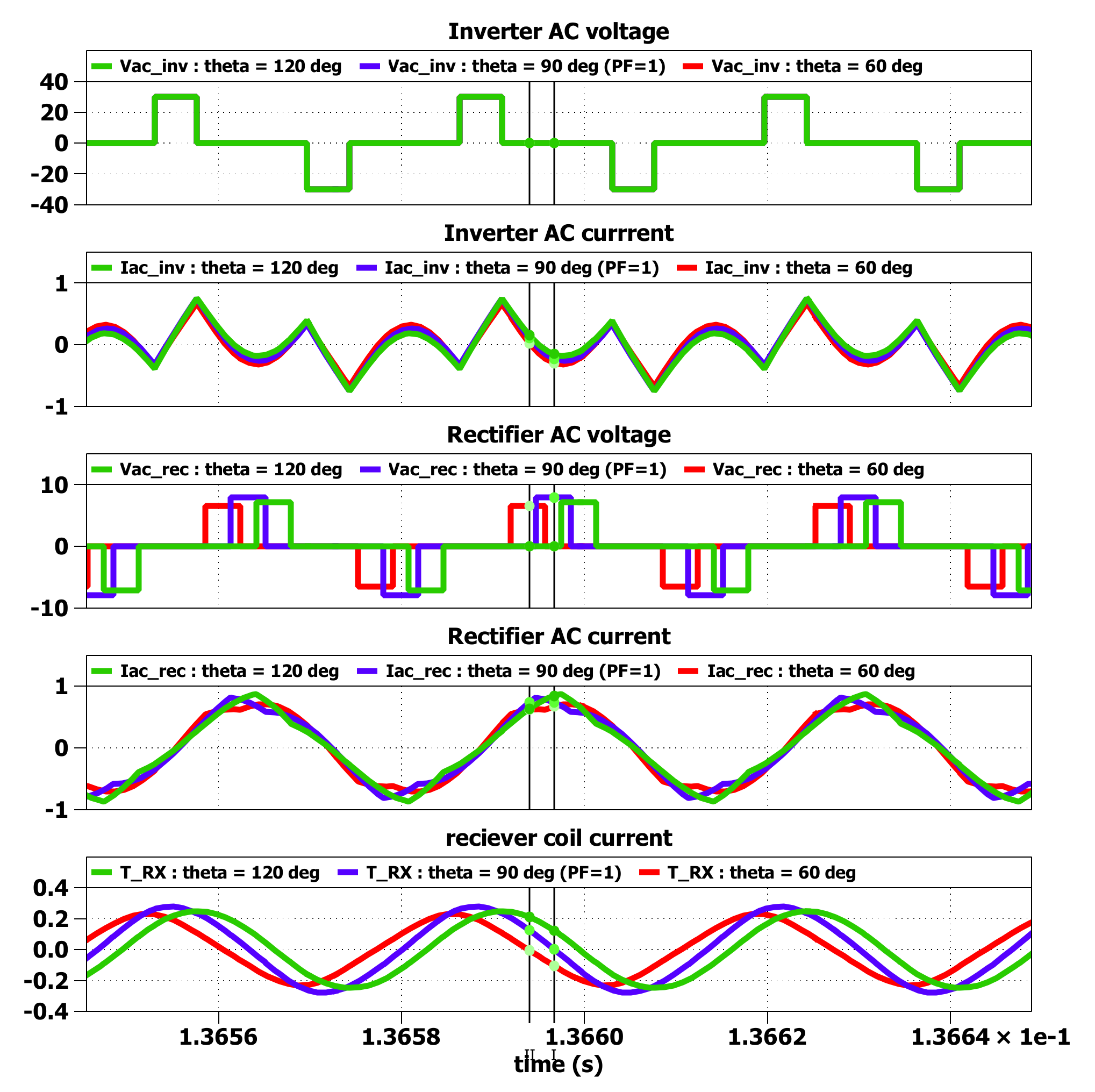
| Symbol | Function Description |
|---|---|
| C1p and C1s | LCC primary and secondary side series compensation capacitances |
| C2p and C2s | LCC primary and secondary side parallel compensation capacitances |
| L1p and L1s | LCC primary and secondary side compensation inductance |
| Vdc_inv = Vdc | inverter DC input voltage |
| Idc_inv | inverter DC input current |
| Vdc_rec = Vo | rectifier DC output voltage |
| Idc_rec = Io | rectifier DC output current |
| Rdc | rectifier DC output side equivalent battery DC resistance |
| Rac = Rac_out | rectifier AC side equivalent resistance = LCC resonant circuit load resistance |
| Rac_in = Rac_inv | Inverter AC side equivalent resistance = Inverter AC load resistance |
| Phase shift angle (degree) | Symbol | Generation: Phase shift angle generated by the positive zero-crossing time (angle) difference of PWM carrier signals | Results: phase shift angle shown in DAB AC voltage waveforms |
| Inverter | “βp (deg)” | between inverter “Leg 1” and inverter “Leg 2” | pulse-width of inverter AC voltage |
| Rectifier | “βs (deg)” | between rectifier “Leg 1” and rectifier “Leg 2” | Pulse-width of rectifier AC voltage |
| Inverter-to-rectifier | “δ (deg)” | between inverter “Leg 1” and rectifier “Leg 1” | phase difference between inverter and rectifier AC voltages |
| Symbol | Parameter | Value |
|---|---|---|
| L1 = L2 | Self-inductance of Tx coil and Rx coil | 180 µH |
| Lm | Mutual inductance between of Tx coil and Rx coil | 41.925 µH |
| Lrp = Lrs | The leakage inductance of Tx coil and Rx coil Lrp = L1 − Lm; Lrs = L2 − Lm | 138.075 µH |
| k | Coupling factor | 0.221 |
| R1 = R2 | Resistance of Tx coil and Rx coil | 0.5 |
| d | Airgap between Tx and Rx | 15 cm |
| Symbol | Parameter | Value |
|---|---|---|
| Vdc | DC input voltage | 30 V |
| Vo | DC output voltage | 24~48 V |
| Po | Maximum DC output power | 50 W |
| fsw | Resonant frequency | 30 kHz |
| Rdc (norm) | Nominal DC load resistance | 47 Ω |
| Rac (norm) | Nominal AC load resistance | 38 Ω |
| Symbol | Parameter | Value |
|---|---|---|
| L1p = L1s | Compensation inductance | 68.65 µH |
| C1p = C1s | Series compensation capacitance | 248 nF |
| C2p = C2s | Parallel compensation capacitance | 410 nF |
| Test Cases | Vo = 10 V, Rac = 38 Ω | |||
|---|---|---|---|---|
| Rdc = 56 Ω | Rdc = 200 Ω | |||
| Inverter/Rectifier AC Voltage and Current | Experiment | Simulation | Experiment | Simulation |
| Inverter RMS voltage (V) | 15.40 | 14.77 | 8.62 | 8.89 |
| Inverter RMS current (A) | 0.549 | 0.610 | 0.283 | 0.254 |
| Rectifier RMS voltage (V) | 10.19 | 8.27 | 6.54 | 5.66 |
| Rectifier RMS current (A) | 0.507 | 0.522 | 0.184 | 0.217 |
| Test Cases | Rac = 38 Ω, Rdc = 56 Ω | |||
|---|---|---|---|---|
| Vo = 10 V | Vo = 30 V | |||
| Input/Output AC Signals | Experiment | Simulation | Experiment | Simulation |
| Inverter RMS voltage (V) | 15.40 | 14.77 | 21.14 | 23.91 |
| Inverter RMS current (A) | 0.549 | 0.610 | 1.31 | 1.32 |
| Rectifier RMS voltage (V) | 10.19 | 8.27 | 27.61 | 27 |
| Rectifier RMS current (A) | 0.507 | 0.522 | 0.822 | 1.19 |
| Vo (V) | Disabled Rac = 38 Ω Feedback Control βs (deg) = 180° | Enabled Rac = 38 Ω Feedback Control | ||||||
|---|---|---|---|---|---|---|---|---|
| V_Pri (V) | I_Pri (A) | V_Sec (V) | I_Sec (A) | V_Pri (V) | I_Pri (A) | V_Sec (V) | I_Sec (A) | |
| 10 | 17.23 | 0.654 | 20.34 | 0.713 | 9.18 | 0.299 | 14.79 | 0.437 |
| 20 | 22.08 | 0.911 | 42.75 | 1.414 | 18.05 | 0.552 | 28.29 | 0.839 |
| 30 | 26.21 | 1.113 | 64.3 | 2.07 | 28.4 | 0.818 | 42.15 | 1.22 |
| 40 | 32.31 | 1.342 | 87.53 | 2.762 | 38.3 | 1.092 | 56.78 | 1.617 |
Publisher’s Note: MDPI stays neutral with regard to jurisdictional claims in published maps and institutional affiliations. |
© 2022 by the authors. Licensee MDPI, Basel, Switzerland. This article is an open access article distributed under the terms and conditions of the Creative Commons Attribution (CC BY) license (https://creativecommons.org/licenses/by/4.0/).
Share and Cite
Cheong, Y.; Cao, S.; Naayagi, R.T.; Lee, S. Triple Phase Shift Control of Wireless Charging DAB LCC Resonant Converter for Unity Power Factor Operation with Optimized Rectifier AC Load Resistance. Appl. Sci. 2022, 12, 11871. https://doi.org/10.3390/app122211871
Cheong Y, Cao S, Naayagi RT, Lee S. Triple Phase Shift Control of Wireless Charging DAB LCC Resonant Converter for Unity Power Factor Operation with Optimized Rectifier AC Load Resistance. Applied Sciences. 2022; 12(22):11871. https://doi.org/10.3390/app122211871
Chicago/Turabian StyleCheong, Yanni, Shuyu Cao, Ramasamy Thaiyal Naayagi, and Szesing Lee. 2022. "Triple Phase Shift Control of Wireless Charging DAB LCC Resonant Converter for Unity Power Factor Operation with Optimized Rectifier AC Load Resistance" Applied Sciences 12, no. 22: 11871. https://doi.org/10.3390/app122211871
APA StyleCheong, Y., Cao, S., Naayagi, R. T., & Lee, S. (2022). Triple Phase Shift Control of Wireless Charging DAB LCC Resonant Converter for Unity Power Factor Operation with Optimized Rectifier AC Load Resistance. Applied Sciences, 12(22), 11871. https://doi.org/10.3390/app122211871








